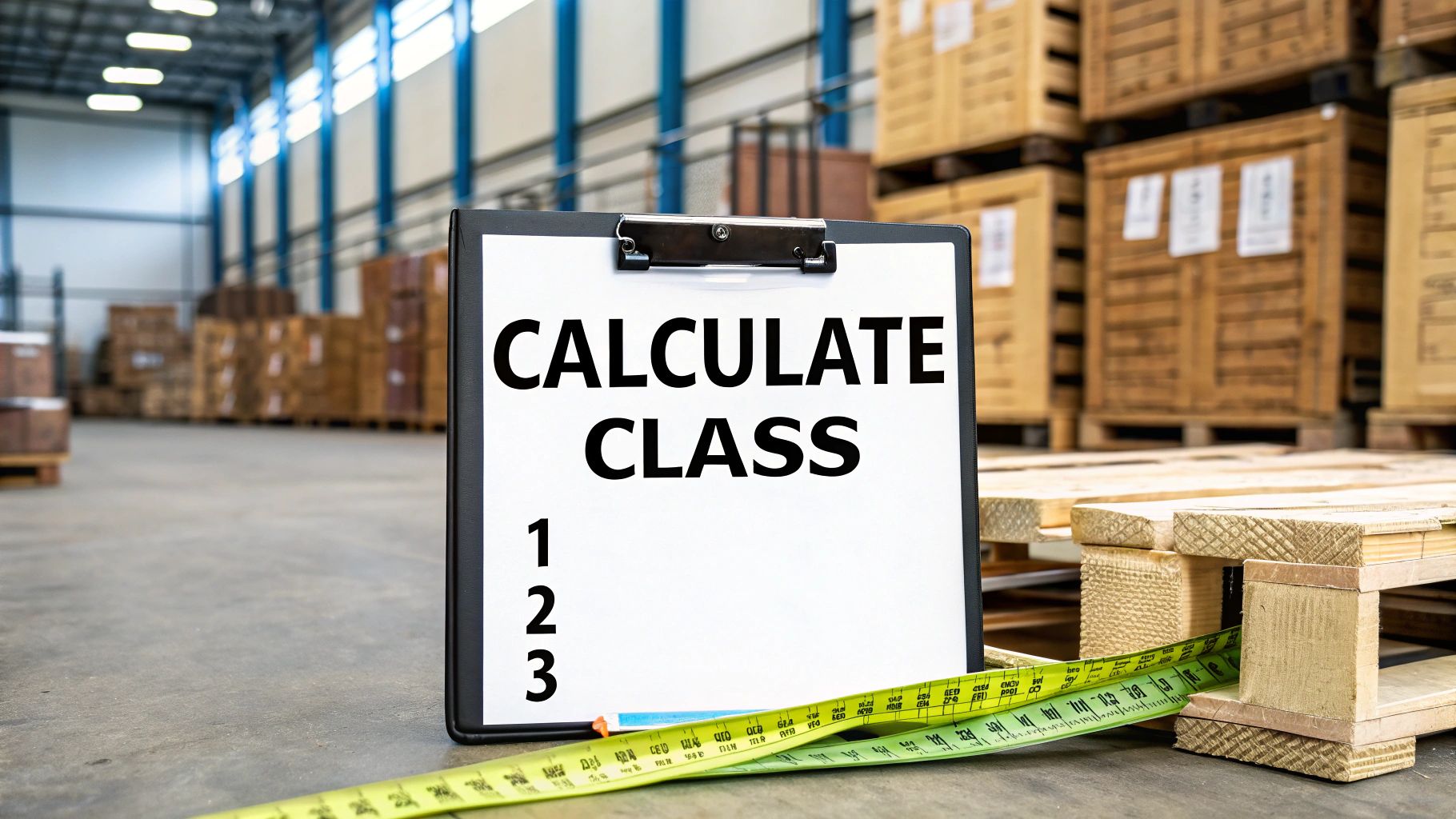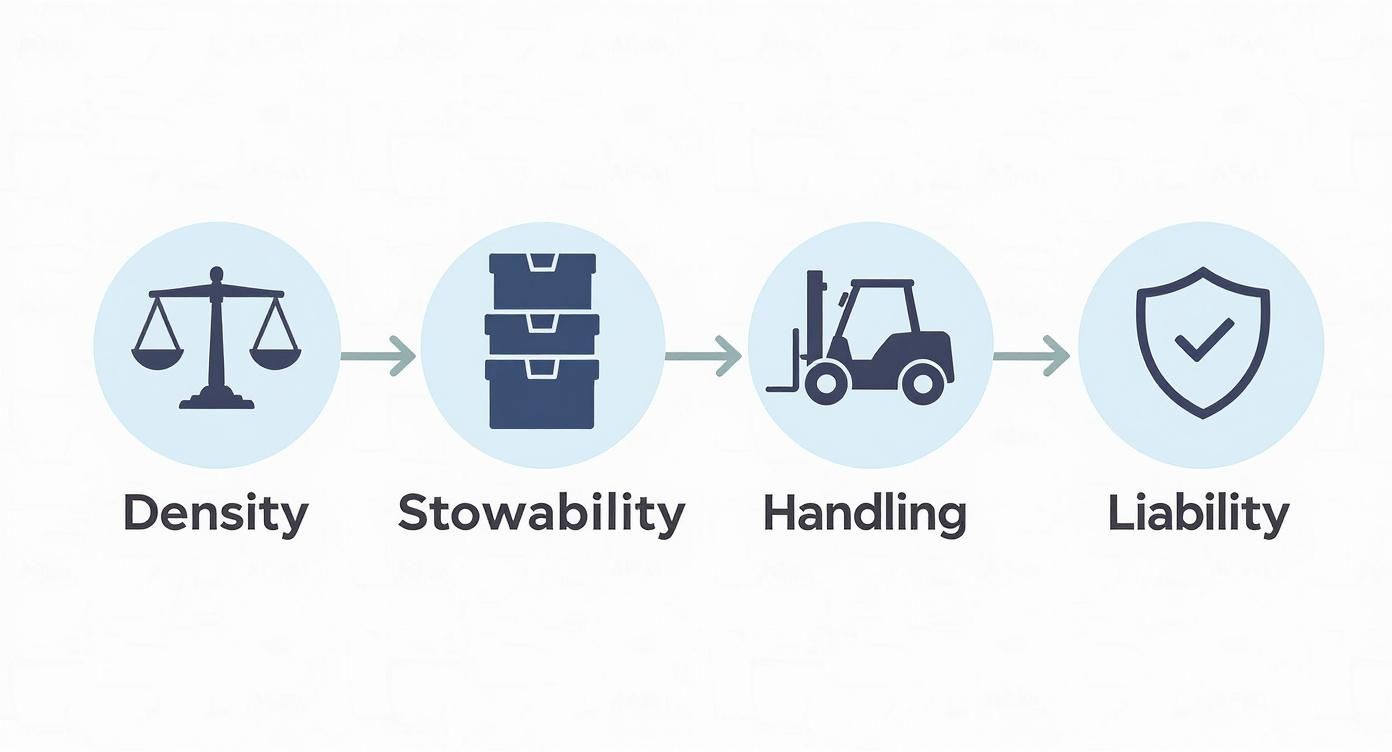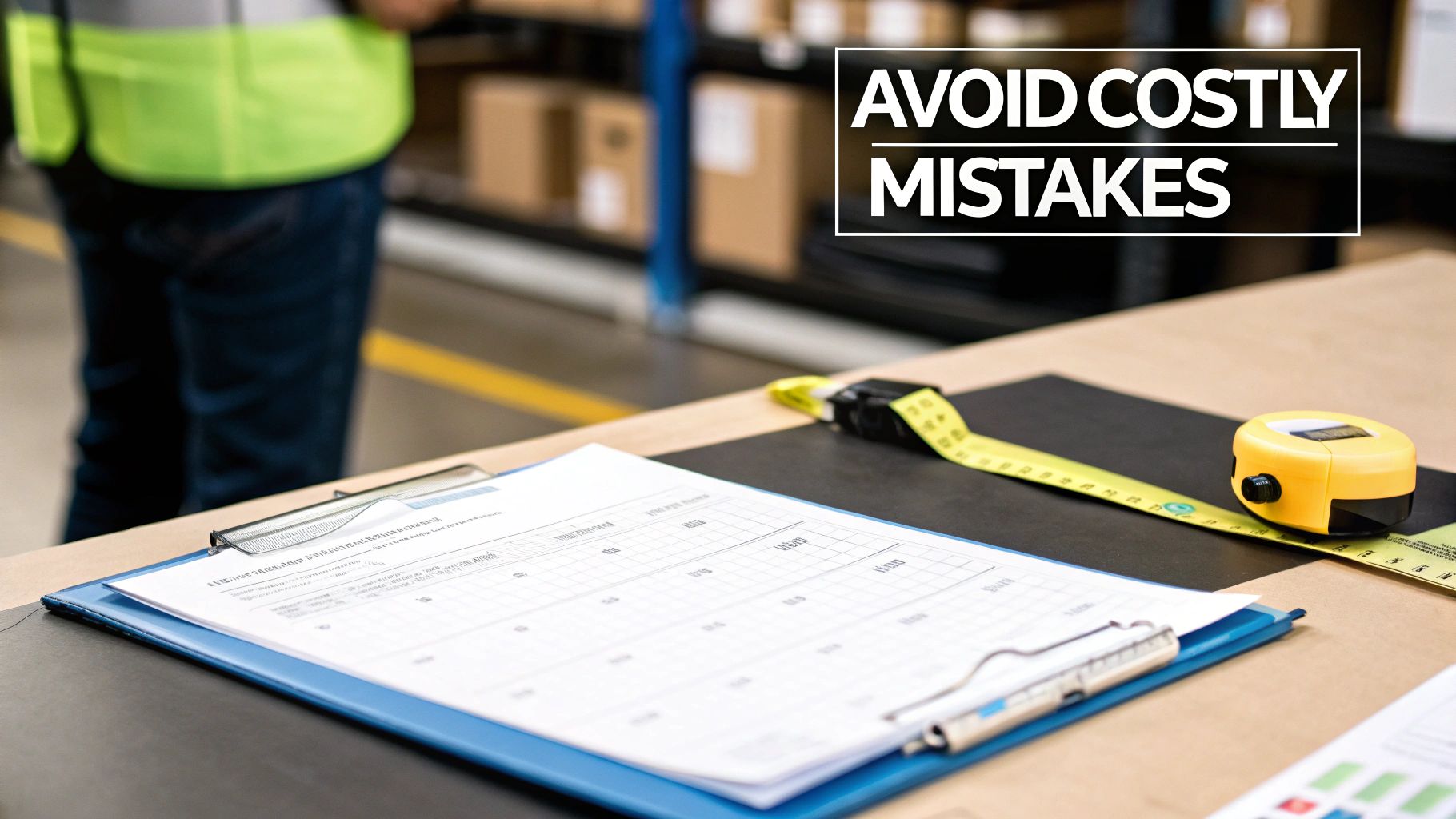Learn how to calculate class for freight with our guide. Master density, NMFC codes, and key factors to lower your LTL shipping costs and avoid fees.

Figuring out the right freight class for your shipment isn't just about plugging numbers into a calculator. You need to understand the why behind it. It all boils down to four key characteristics: density, stowability, handling, and liability. Getting a handle on these concepts is the first step to accurately classifying your freight and keeping your shipping costs in check.
Before we get into the nitty-gritty of measurements and codes, let's talk about what freight class really is and why it has such a huge impact on your budget.
Think of it as the universal pricing language for Less-Than-Truckload (LTL) shipping. When you get it right, your costs are predictable. When you get it wrong, you're in for some nasty surprises.
The whole point of this system is to standardize how carriers price shipments that have wildly different characteristics. Imagine a pallet of solid steel bricks and a pallet of delicate, hand-blown glass vases. They might take up the exact same footprint on a truck, but you can bet their shipping costs will be miles apart. Freight class is the system that makes sense of that difference.
This entire framework is managed by the National Motor Freight Traffic Association (NMFTA) through a system called the National Motor Freight Classification (NMFC). It's been the industry standard since 1936 and is still the cornerstone of LTL freight pricing today.
The NMFC categorizes every conceivable commodity into one of 18 freight classes, from the low-cost Class 50 (think dense, durable stuff like nuts and bolts) all the way up to the high-cost Class 500 (think extremely low-density items like ping pong balls).
It’s pretty simple: the lower the class, the cheaper it is to ship.
Getting this wrong is a big deal. Carriers regularly inspect and re-weigh shipments. If they find you’ve used the wrong class, they’ll hit you with a reclassification adjustment and a steep fee. Those unexpected charges can completely blow up a project's budget and cause a real logistical nightmare.
To really understand how to calculate freight class, you have to look at your shipment the way a carrier does. They're assessing the risk and effort involved in moving your goods, and they do it by looking at four main things.
Each of these factors plays a crucial role in determining that final number. A shipment might be dense (which is good), but if it's also fragile and a high-value theft risk, those other factors will push its class—and its cost—right back up.
Even if you're only dealing with smaller goods, having a grasp on internal product shipping classifications can help you anticipate potential shipping hurdles down the road.
For a more detailed look into how LTL works, be sure to read our guide on what LTL stands for in shipping.
When it comes to Less-Than-Truckload (LTL) shipping, density has become the single biggest factor that dictates your freight class. Sure, other characteristics play a role, but how much space your shipment takes up relative to its weight is what really drives the final cost. Getting this calculation right isn't just a good idea—it's absolutely essential if you want to avoid those nasty, unexpected charges on your invoice.
Think of it this way: carriers are in the business of selling space on their trucks. A pallet of dense engine blocks might take up the same footprint as a pallet of fluffy pillows, but their shipping costs will be worlds apart. The pillows hog valuable space without adding much weight, making them less profitable for the carrier. This is why mastering the density calculation is the most critical part of figuring out how to calculate class for freight.
The good news is that the math itself isn't too complicated. You just need three key measurements: the length, width, and height of your fully packaged shipment, plus its total weight.
The density formula is pretty simple:
Weight (in pounds) / Volume (in cubic feet) = Density (in PCF)
Here's how you get that volume number:
Key Takeaway: Always, and I mean always, measure your freight after it’s fully packaged and sitting on the pallet. Forgetting to include the pallet's dimensions is one of the most common—and costly—mistakes I see shippers make. Our guide to standard shipping pallet sizes can help you factor this in correctly.
This infographic does a great job of breaking down the four main factors that influence your freight class, with density sitting right at the top.

As you can see, density, stowability, handling, and liability all come together to determine your final classification and, ultimately, your shipping bill.
Don't think for a second that carriers won't check your work. They can, and absolutely will, re-weigh and re-measure shipments if something looks off. A huge chunk of LTL shipments get re-classified, leading to surprise fees. On the flip side, just a little effort to optimize your packaging and increase density can trim your shipping costs by 5–10%. Accurate calculations are a direct path to savings.
For those shipping liquids or bulk goods, knowing how to take precise IBC tote measurements is a must for an accurate density calculation.
Once you have your PCF figured out, you're ready to find your class. You'll compare your number to a standard NMFC density chart. Just remember the golden rule: the higher the density, the lower the class—and the lower the cost.
While density is definitely the headliner when it comes to LTL shipping costs, it’s not the whole show. There are three other major players on stage: stowability, handling, and liability. I’ve seen it time and time again—shippers get a nasty surprise with a higher freight class because they only focused on density. These other characteristics give carriers the full picture of what it’ll actually take to get your goods from A to B safely.

To really master how to calculate class for freight, you need to get a handle on how these elements shape your final classification. Let’s dig into what they really mean for your shipment.
Simply put, stowability is all about how well your shipment plays with others. Carriers are Tetris masters, trying to fit as much freight as possible into a trailer. Anything that makes their job harder is going to cost you.
Items with great stowability are a carrier's dream—think perfectly square boxes stacked neatly on a standard pallet. They’re easy to load, stack, and fit snugly next to other freight.
But then you have items with poor stowability, which are the source of major logistical headaches. These include things like:
An item that's a pain to stow takes up more than its fair share of space and complicates the whole loading process. That will almost always bump it into a higher freight class.
Handling and liability go hand-in-hand, focusing on the ease and risk involved in moving your goods.
Handling is about any special attention your freight needs to get on and off the truck. Most freight is a simple forklift job. But if your items are exceptionally fragile, heavy, or have a strange shape, they might need special equipment or a much more delicate touch. The tougher your shipment is to handle, the higher its class will climb.
Think about a pallet of concrete blocks versus a pallet of high-end, fragile electronics. The blocks are dense and can be moved quickly. The electronics? They need to be loaded with extreme care to avoid a costly accident. That difference in handling is a big reason the electronics land in a much higher class.
Liability, on the other hand, is all about the value of your shipment and how likely it is to be damaged or stolen. Carriers take on risk with every single item they transport.
A shipment of industrial steel, for instance, has very low liability. It’s tough to damage and not exactly a hot item for thieves. Now, compare that to a pallet of brand-new laptops. They're fragile, incredibly valuable, and a prime target for theft. That makes them a high-liability shipment, which will push their freight class way up, no matter what their density is.
Okay, so you understand the "why" behind freight class. Now for the "how." The good news is you don't have to wing it or pull out a dusty old calculator. The freight industry has standardized tools that take the guesswork out of the equation, making sure everyone is on the same page. Let's talk about NMFC codes and the online calculators that have become a shipper's best friend.
Think of a National Motor Freight Classification (NMFC) code as the universal product number for freight. Every single commodity, from bolts to basketballs, gets a specific number. This code is the key that unlocks its official freight class, as it's directly tied to the four big factors: density, stowability, handling, and liability.
Getting the NMFC code right isn't just a suggestion—it's essential for getting an accurate LTL quote. One of the most common pitfalls I see is shippers picking a code that's close enough. This almost always ends in a carrier reclassification, and trust me, that comes with a surprise adjustment on your final bill.
Every item has its place. The National Motor Freight Traffic Association (NMFTA) is the official keeper of this massive database. Their platform, ClassIT, is the definitive source for looking up any commodity and finding its assigned NMFC.
This is the tool the pros use. By referencing the official source, you're eliminating any room for error and ensuring the information on your Bill of Lading (BOL) is rock-solid.
While the NMFC code tells you the commodity's base classification, you still have to account for your specific shipment's density to get the final class. This is where a freight class calculator becomes an absolute lifesaver. These online tools are designed specifically to prevent simple math mistakes that can cost you dearly.
Instead of wrestling with formulas and charts, you just plug in a few details. It's that simple.
In a split second, the calculator will spit out your shipment's volume, determine its density in pounds per cubic foot (PCF), and give you the correct freight class. What used to be a tedious, error-prone task is now done in a flash, giving you the accurate info you need to get a reliable shipping quote.
Even seasoned pros can make small slip-ups that lead to some seriously big costs. When you're dealing with LTL freight, getting the details right is everything. A simple oversight can easily result in expensive reclassification fees from the carrier, surprise adjustments on your invoice, and painful shipping delays. Getting a handle on these common pitfalls is a huge part of mastering freight class and protecting your budget.

One of the most common mistakes I see? Guessing on the weight or dimensions. It’s tempting to just eyeball it, but carriers use certified scales and laser dimensioners that are ruthlessly accurate. If their numbers don't line up with yours—even by just a few inches or pounds—you can bet an adjustment invoice is coming your way. The old carpenter's adage holds true here: measure twice, ship once.
This one gets people all the time. You have to include the pallet and all your packaging when you calculate the final measurements and weight. Your shipment's official dimensions are measured from its absolute widest, longest, and tallest points after it’s all packed, wrapped, and strapped to the pallet. The weight of the pallet itself has to be part of the total gross weight, too.
Here’s a real-world example: A client was shipping custom metal signs and calculated their freight class based on the sign's dimensions alone. But once crated, the shipment was 6 inches wider and 50 pounds heavier. That seemingly small difference bumped it into a higher, more expensive class, landing them a $250 reclassification fee on a single pallet. Ouch.
Paying attention to these little details is exactly what carriers do during inspections. Nailing them upfront is a simple but powerful way to reduce your overall shipping costs.
Picking an NMFC code that’s just "close enough" is a recipe for a bad time. The NMFC database is incredibly specific, and for good reason. A classic mistake is classifying a finished product based on the code for its raw materials.
Let's say you're shipping fully assembled wooden cabinets. It might seem logical to use the NMFC code for raw lumber, which has a nice, low freight class because it’s dense and easy to stack. But those assembled cabinets are a different beast entirely—they take up much more space, are way less dense, and are far more likely to get damaged.
That kind of misclassification is a massive red flag for carriers. When they inspect the shipment (and they will), they'll assign the correct, higher-class NMFC code. You'll be on the hook for the price difference, and probably some penalties on top of it.
To keep your shipments moving smoothly and your budget intact, always remember to:
When you focus on getting it right from the very beginning, you can be confident that your quote is accurate and your freight will get where it's going without any costly surprises.
When you're new to LTL shipping, the whole concept of freight class can feel a bit confusing. That's totally normal. To help you get a handle on things and keep your shipping costs in check, let's break down some of the most common questions we hear every single day.
This is probably the most important question, and the answer hits you right in the wallet. Let's say you classify your shipment at a class that’s too low. The carrier is almost guaranteed to catch it during an inspection. When they do, you'll get hit with a reclassification.
A reclassification means you’re on the hook for the price difference between the class you entered and the correct, higher one. As if that's not bad enough, they'll also tack on a penalty fee for the trouble. Those surprise charges can wreck your budget on what you thought was a profitable shipment.
And what if you go the other way and enter a class that’s too high? You’re just overpaying. Carriers don't issue refunds for that kind of mistake, so you’re essentially handing them free money. This is exactly why getting it right from the start is so crucial.
Nope. Freight class is a system built specifically for Less-Than-Truckload (LTL) shipping. Think of it as a way to create a level playing field when dozens of different shipments are all sharing space on the same truck. It’s how carriers balance the cost of hauling a dense pallet of bricks versus a bulky pallet of ping pong balls.
With Full Truckload (FTL), the game is completely different. You're paying for the entire trailer, so it doesn't matter what's inside. The pricing is usually a simple flat rate or a cost-per-mile, not based on the freight's characteristics.
Yes, it absolutely can. This is a detail that trips a lot of people up. The way you package an item can dramatically change its freight class because it all comes down to density, and packaging has a huge impact on that.
Here’s a real-world example: Imagine shipping a standard office desk. If you ship it fully assembled, it’s big and bulky, taking up a ton of space for its weight. That low density means it will fall into a high, expensive freight class.
But what if you take a few minutes to disassemble that same desk and pack it flat in a box? Now it’s much more compact and dense. That simple change moves it into a much lower and more affordable freight class, saving you a good chunk of change on the very same product.
Ready to put this knowledge to work and see what your shipment will cost? Get an accurate, instant price for your LTL or FTL freight.